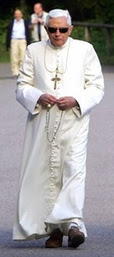Septuagesima brings us face to face with death. The Introit is Circumdedérunt me gémitus mortis (The sorrows of death surrounded me); the ancient chant Media vita (In the midst of life we are in death) is oft sung during the pre-Lenten season; at Matins, the readings begin at Genesis chapter one, and soon enough bring us face to face with the Fall of Man, when, having eaten of the forbidden fruit, death came to mankind, and estrangement from God, which makes death evil.
At the end of Lauds, until the 1950s, after Fidelium animæ the Lord's prayer was said silently, then the versicle Dominus det nobis was sung, followed by the Marian anthem of the season. The 1693 Lyons Breviary adds two words, post mortem, to the second half of this versicle, thus:
V. Dóminus det nobis suam pacem.
R. Et post mortem vitam ætérnam. Amen.
(V. May the Lord grant us his peace.
(R. And, after death, life eternal. Amen.)
This seemed to me a devout addition suitable to use in prayer, since it balances the length of each phrase... but often I have mixed up the words, and said by mistake, Et post vitam mortem ætérnam (And, after life, death eternal)! That is not a prayer to make, lest it be answered!
But more seriously, these are in fact the options we face in this vale of tears:
1. Post mortem, vitam ætérnam (After death, life eternal);
2. Post vitam, mortem ætérnam (After life, death eternal).
Here we have the age-old presentation of the Two Ways, the Way of Life and the Way of Death: either (1) following the narrow path, “denying ungodliness and worldly desires, we should live soberly, and justly, and godly in this world, looking for the blessed hope and coming of the glory of the great God and our Saviour Jesus Christ,” (Titus ii, 12f), or (2), taking the broad road, “many walk, of whom I have told you often (and now tell you weeping), that they are enemies of the cross of Christ; whose end is destruction; whose God is their belly; and whose glory is in their shame; who mind earthly things.” (Phil. iii, 18f).
As Our Lord taught so clearly, “If any man will come after me, let him deny himself, and take up his cross, and follow me. For he that will save his life, shall lose it: and he that shall lose his life for my sake, shall find it. For what doth it profit a man, if he gain the whole world, and suffer the loss of his own soul?” (St Matthew xvi, 24-26). We can either deny ourselves and bear our appointed cross and follow Christ to Calvary, praying for final perseverance, trusting in his grace to save us and bring us to glory, or live vainly, heedless of and hating God, and hateful to him and others and ourselves, and after death perish everlastingly.
Ultimately we must be among the martyrs, the true witnesses to the Crucified at the cost of their own lives, whether literally or in intention – or among the reprobate, who madly purchase worthless transient pleasures at the infinite cost of everlasting damnation. Be sheep or goats, choose!







